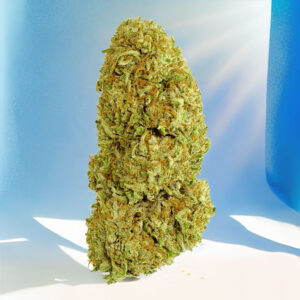70% Off Sitewide! Use code: TAKE70
What is CBG Flower?
CBG flower comes from female industrial hemp plants, just like CBD flower. Both types of hemp flowers have less than .3% THC, but CBG flower contains high levels of cannabigerol (CBG) instead of cannabidiol (CBD).
Scientists often refer to CBG as the “Mother Cannabinoid.” The acid form of CBG, CBGA, breaks down into other cannabinoids such as cannabichromene (CBC), cannabidiol (CBD), and tetrahydrocannabinol (THC) as the plant matures. For this reason, breeders have had a difficult time producing hemp plants with high levels of CBG until relatively recently.
In the past, consumers could only get the benefits of CBG by buying expensive concentrates. Since cannabis and hemp plants typically contain less than 1% CBG, concentrate manufacturers extract CBG from plants that are only six weeks into an eight-week flowering cycle. Even when harvesting early, manufacturers need to use an enormous amount of plant material to extract CBG. The difficulty of extracting the cannabinoid makes CBG concentrates unaffordable for many consumers.
Luckily, we now have access to an increasing selection of delicious high-CBG hemp flowers.
What Does CBG Flower Do?
While research of minor cannabinoids is still in the beginning stages, scientists have found some exciting potential benefits of CBG.
CBG May Help Reduce Inflammation
Similar to its sister cannabinoid, CBD, CBG seems to have the ability to help reduce inflammation. Researchers are particularly interested in CBG’s potential ability to reduce the inflammation associated with digestive disorders like Irritable Bowel Syndrome (IBS) and colitis.
CBG and Intraocular Pressure
Both THC and CBG have been shown to reduce the excess intraocular pressure associated with glaucoma. But unlike THC, CBG is non-psychoactive. CBG may be a useful alternative for people who want to reduce intraocular pressure without experiencing any of the intoxicating effects of THC.
CBG to Calm Muscle Contractions
Researchers are studying the potential of CBG to help calm involuntary muscle contractions related to bladder dysfunctions. CBG significantly reduced acetylcholine-induced contractions in both animal and human studies.
CBG for Reducing Stress
CBG has been shown to have anxiolytic properties. CBG interacts with the CB-1 receptor and boosts levels of one of the body’s principal endocannabinoids, anandamide. The researcher who discovered anandamide named it after the Hindu word “ananda,” which means “bliss” in Sanskrit. Anandamide is responsible for the ‘runner’s high’ that athletes get after working out.
Additionally, CBG has been shown to contribute to GABA reuptake inhibition. More GABA in the bloodstream helps to relax the muscles and promote a sense of mental calm. Physicians often prescribe the GABA reuptake inhibitor Tiagabine for anxiety. However, like most pharmaceuticals, GABA reuptake inhibitors come with side-effects, especially when taken in larger doses for more extended periods. CBG may prove to be a healthier alternative in the future.
CBG to Soothe Common Aches and Pains
CBG’s anti-inflammatory action may make CBG flower useful for calming everyday aches and pains. Some research also suggests that CBG may be a more potent analgesic than other cannabinoids due to the molecule’s ability to inhibit GABA uptake and its exceptional affinity for CB-1 and CB-2 receptors.
CBG as an Antibacterial Agent
Researchers have been studying CBG as a potential treatment for Methicillin-resistant Staphylococcus aureus (MRSA) bacteria. MRSA infections are common in hospitals and can be life-threatening since the bacteria refuse to respond to traditional antibiotics. In vitro studies showed a significant decrease in gram-negative bacteria after treatment with CBG. Cannabinoids like CBG may become increasingly useful weapons in the fight against antibiotic-resistant bacteria.
CBG as an Antioxidant
Like most cannabinoids, CBG seems to reduce oxidative stress and serve as a neuroprotectant. Researchers have been particularly focused on CBG as a potential treatment for Huntington’s Disease. Preliminary experiments in mice showed a significant improvement in the motor deficits associated with the disease. Although much more research is required, CBG may be able to help improve the lives of people struggling with neuropathic disorders in the future.
CBG May Help to Slow Down Tumor Growth
According to the World Health Organization, cancer claims the lives of nearly 10 million people worldwide each year. An international study from 2009 concluded that CBG and other non-psychoactive cannabinoids might have the potential to slow tumor growth. A 2014 study found CBG effective in promoting the apoptosis of tumor cells in colorectal cancer.
CBG May Stimulate the Appetite
While millions of people lose their lives to cancer each year, many more struggle with the debilitating effects of chemotherapy. Both anecdotal evidence and animal studies have shown that CBG stimulates the appetite. MMJ doctors often recommend THC-containing cannabis for their patients undergoing chemotherapy. CBG may provide a non-psychoactive alternative for patients who can’t tolerate the psychoactive effects of THC.
CBG Reduces the Effects of THC
CBG is not only non-psychoactive, but the cannabinoid also lessens the psychoactive effects of THC. CBG attaches to the CB-1 receptor and blocks THC molecules from binding at the same site. Consumers living in legal cannabis states can mix CBG flowers with THC-containing cannabis for a milder effect.
Is CBG Better Than CBD?
Both CBD and CBG interact with the CB-1 and CB-2 receptors in the body’s endocannabinoid system (ECS). CBD and CBG have similar effects, including:
- Reducing inflammation
- Boosting levels of natural endocannabinoids
- Exhibiting neuroprotective properties
- Inhibiting the intoxicating effects of THC
- Promoting the apoptosis of cancer cells
It’s difficult to accurately judge which cannabinoid is better at this time. Much more research is needed. Furthermore, cannabinoids like CBG and CBD work together in a synergistic manner, causing the beneficial entourage effect. Taking advantage of the entourage effect is an excellent reason to choose whole hemp flower and full-spectrum concentrates.
However, CBG may provide a better option for people with glaucoma. CBG and THC both help to reduce intraocular pressure. Unfortunately, CBD doesn’t seem to have the same effect. CBG may become a helpful non-psychoactive alternative for glaucoma patients currently being treated with THC.
Side Effects of CBG
At this time, we can only rely on consumer reports and animal studies, but CBG seems to be well-tolerated and produce little to no side-effects. However, CBG may interact with certain prescriptions, especially medications that carry a grapefruit warning. It’s always a good idea to talk to your trusted medical professional before adding any new substance, including CBG, into your daily routine.
Is CBG Flower Legal?
All hemp flower that contains less than .3% delta-9 THC is legal on the federal level. THC is the cannabinoid responsible for the intoxicating effects that cannabis consumers experience. Like CBD, CBG is a non-psychoactive cannabinoid and isn’t of particular concern to federal authorities.
While CBG flower is completely legal federally, a few U.S. states have passed laws against certain CBD products and hemp flower. If you live in a no-flower state or plan to visit one, you may want to skip the hemp flower. Another alternative is to buy your CBG from a reputable online vendor like JustKana and keep your use discreet.

